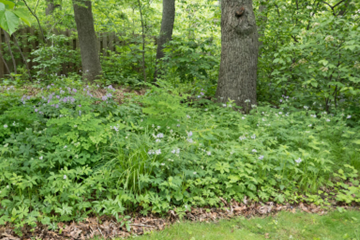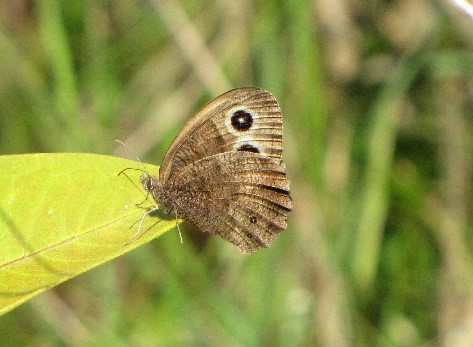Posted: June 13, 2023
Soft landings are native plants under native trees that provide critical shelter and habitat for beneficial insects. As gardeners, we often focus on providing the right food for pollinators and neglect to consider the microhabitat needed to complete their entire life cycle a space to pupate and grow.

Photo Credit: Soft Landing, Heather Holm
Everybody needs a home. A place to live and rest, a place to eat, reproduce, and grow a place to provide shelter as we go through various stages of life.
Pollinators are no different, yet as gardeners we often focus on providing the right food for pollinators and neglect to consider the microhabitat needed to complete their entire life cycle - a space to pupate and grow.
The larvae of the Polyphemus moth provide an example of how to create such a space. Once the caterpillars have eaten their fill of leaves, they spin a cocoon in which they overwinter and pupate on their host tree; 94% of all species of caterpillars however, pupate off the host tree. After weeks of feeding, the caterpillars drop to the ground where they spin a cocoon in the leaf litter or burrow into the soil to pupate underground. The host trees in this example are more generally known as keystone plants which are native plants that support a significant number of butterfly and moth caterpillars. And the spaces beneath keystone trees where the pupa end up are known as soft landings which are diverse native plantings under keystone trees.
Examples of keystone plants include Quercus (Oak) Prunus (Cherry) and Salix (Willow). Keystone plants help to build complex food webs by forming the essential foundation-native plants and insects- that directly or indirectly provide food for other organisms. Soft landings play a critical role in the life cycle of pollinators by providing shelter and habitat for moths, butterflies, bumble bees, fireflies, lacewings, and beetles. Planting ground covers such as native pachysandra, native ferns, woodland phlox, foam flower, ginger or other native plants within the drip line of keystone trees not only provide a soft landing for 94% of caterpillars, but they help to build healthy, pliable soil for burrowing insects. Using these plantings eliminates the need for landscape fabric and mowing - two common practices that are a detriment to pollinator friendly habitat because they cause soil compaction or present barriers to burrowing insects.
The passive act of leaving leaf litter in place, allowing plant debris and dead stalks to hold sentry over your garden throughout the winter and early spring, and using decaying logs and rocks as a design feature, also provides pupation sites for pollinators such as the beautiful Common Wood Nymph and Greater Oak Dagger moth. It has the added bonus of saving you work while improving soil quality as organic matter is broken down through the decay of the leaves and logs.

As we grow as home gardeners, it's important we expand our vision to include and incorporate soft landings into our garden design. By choosing a variety native ephemerals, perennials, sedges and ferns, we can enjoy seasonal succession of blooms and textures that compliment other garden beds within our landscapes. At the same time, we can provide crucial habitat, the "home" that our pollinators need to live out their life cycle.
Article written by Ann Foster, Penn State Master Gardener, Monroe County
References:
Tallamy, Douglas. Nature's Best Hope: A New Approach to Conservation That Starts in Your Yard. Portland, Oregon: Timber Press, 2019.
Bee and Pollinator Books by Heather Holm. Soft Landings: What are Keystone Plants Handout.

